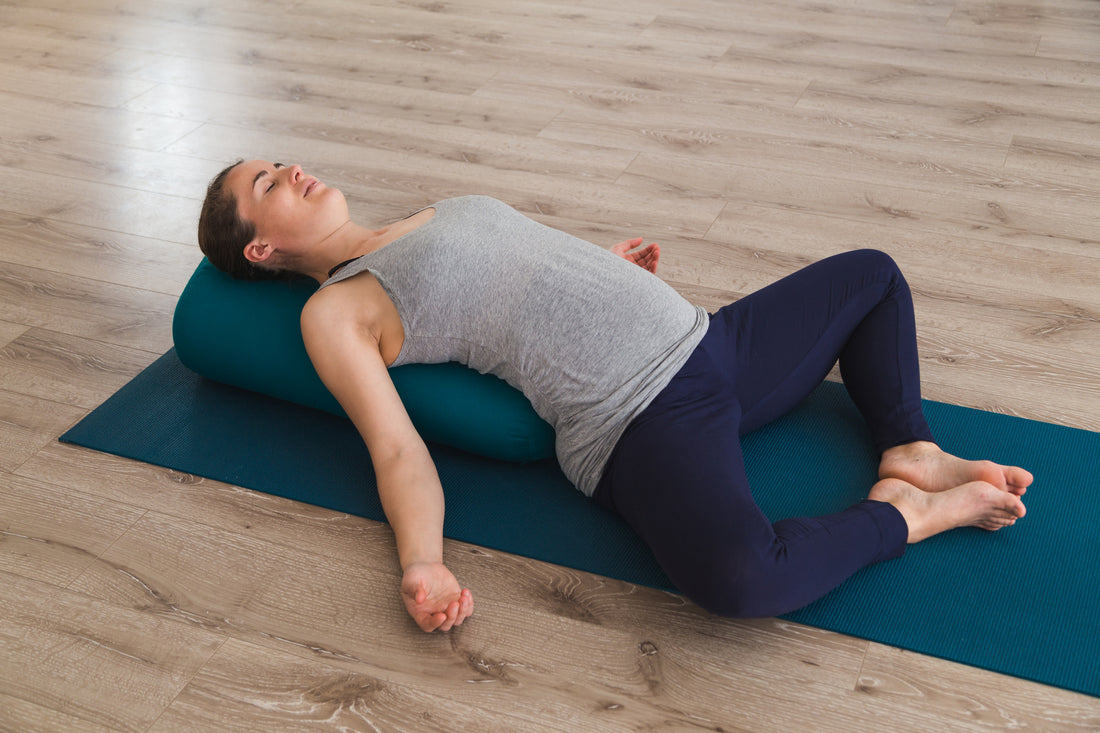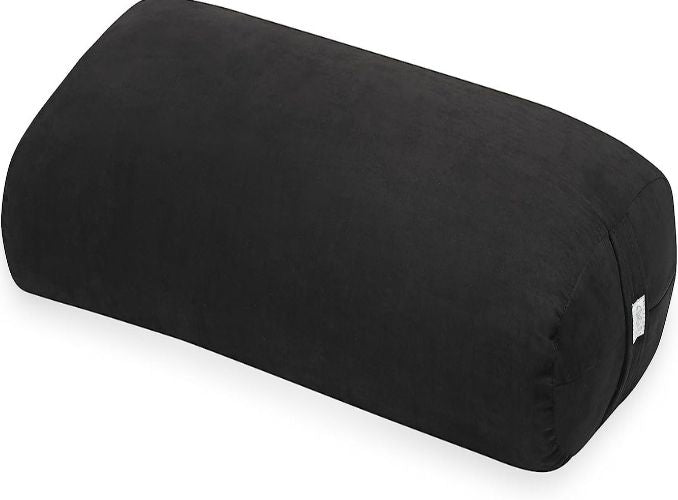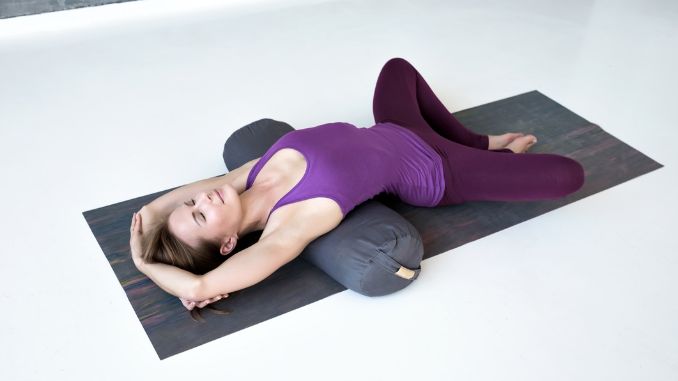
Yoga Bolster: Relaxing and Supportive Prop
What is the meaning of bolster in yoga? The word "bolster" means to support or prop up. They are made from various materials, including cotton, buckwheat, and kapok. Bolsters are designed to support your body in various yoga poses and help improve alignment, relax the body, and deepen the practice.
Additionally, a yoga bolster is like a gentle cushion that tenderly invites you to surrender to the moment, release the tension in your muscles and mind, and embrace the stillness within.

What does a Yoga Bolster do?
There are many benefits to using yoga bolsters in your practice. Additionally, here are just a few:
- Provides support and comfort. Bolsters can also help to support your body in poses that can be challenging or uncomfortable. This can allow you to relax and deepen your practice.
- Improves alignment. Additionally, bolsters can help to improve your alignment in poses by providing support where you need it most. This can prevent injuries and improve your overall form.
- Relaxation. Bolsters can also be used in therapeutic poses that promote relaxation and reduce stress.
- Accessibility. Moreover, bolsters can make yoga poses accessible to people of all ability levels. For example, they can support your lower back in poses like Downward-Facing Dog or prop up your legs in poses like Supported Bridge Pose.
4 Types of Yoga Bolsters
To use these bolsters, you can place them under your back, hips, legs, or head, while depending on your pose. You can also adjust the firmness and shape of the bolsters by removing or adding some of the kapok filling and checking the bolsters that come with the care instructions.
1. Round Bolsters
These are the most common type of yoga bolster. Additionally, they are usually 12-18 inches in diameter and 6-8 inches tall.
Organic Zafu Meditation Cushion
|
Round bolsters are versatile and can be used for a variety of poses, including:
|
 |
2. Rectangular Bolsters
These props are typically 24-30 inches long, 12-18 inches wide, and 4-6 inches tall.
|
Rectangular bolsters are a good option for poses that require more support, such as:
|
 |
3. Yoga Bolster Pillow
These small, soft yoga props support the restorative poses of the head, neck, and shoulders. Yoga pillows are also typically 12-14 inches long, 10-12 inches wide, and 4-6 inches tall.
Luxurious Eco Suede Yoga Bolster
4. Cylindrical
A cylindrical yoga bolster is usually about 25 to 28 inches long and 8 to 10 inches in diameter.
A cylindrical bolster can also help ease pain and tension by releasing tightness in your SITS muscles (Supraspinatus, Infraspinatus, Teres minor, and Subscapularis), lats, intercostals, and other areas prone to stress and inflammation.
|
Type |
Description |
Benefits |
|
Round bolster |
The most common type of yoga bolster. |
Versatile and can be used for a variety of poses. |
|
Rectangular bolster |
A good option for poses that require more support. |
Provides more stability than a round bolster. |
|
Pillow |
Small, soft pillows that support the head, neck, and shoulders. |
Comfortable and can help relax the body. |
|
Cylindrical/Oval |
Provide support, comfort, and relaxation, especially with backbends, chest openers, and restorative postures. |
Deepen your stretch and increase your flexibility by enabling you to reach further and hold longer in various poses. |
You can also use organic cotton products, which are soft, breathable, and eco-friendly. Farmers grow these cotton products free from harmful chemicals, pesticides, or fertilizers, which are better for your skin, health, and the environment. Additionally, you can opt to machine wash for convenience.
You should be able to remove and machine wash the pillowcase. Choose a bolster with handles on either side for easy transport.
Furthermore, the best type of yoga bolster depends on your needs and preferences. If you are new to yoga, starting with a round bolster is a good idea. Experiment with different types of bolsters as you become experienced to find what works best for you.
How to Choose Yoga Bolster?
When choosing a yoga bolster, consider your requirements and personal preferences. Moreover, here are a few things to keep in mind:
- Size and shape: Yoga bolsters vary in dimensions, from 18-30 inches in length and 6-12 inches in width and height, also depending on the type of pose you want and the level of support you need. For example, round bolsters are more versatile and flexible. Additionally, they can be used for backbends, chest opening, and meditation. Depending on your body size and comfort, you can also choose smaller or larger bolsters.
- Material and filling: Additionally, yoga bolsters are usually made of organic cotton or polyester fabric, which are durable, breathable, and eco-friendly. The fabric also can be patterned and plain or have a zipper or a flap for easy removal and washing. Additionally, the filling of the bolster can be cotton, foam, or polyester batting, which are lightweight, resilient, and hypoallergenic. The stuffing can also be adjustable, so you can add or remove some of it to change the firmness and shape of the bolster.
- Price and quality: Yoga bolsters can range from $30 to $100, also depending on their quality, features, and brand.
- You can compare different options and also find the best value for your money.
- Look for sales, discounts, or coupons to save money.
- Also check the reviews and ratings of the bolsters.
- Choose high-quality, durable, comfortable, and easy-to-care-for bolsters.
How to Use Yoga Bolsters?
They can be used in various ways, depending on the type of yoga you practice and the pose you want to do. Here are some general tips on using them:
- Place the bolster under your back, hips, legs, or head, depending on your pose and the level of support you need. You can adjust the height and angle of the bolster using other props, such as blankets, blocks, or straps.
- Moreover, relax your body and mind, and breathe deeply and slowly. Then, hold the pose for at least a few minutes or as long as you feel comfortable. You can also close your eyes and focus on your breath, sensations, and thoughts.
- Also, to come out of the pose, gently move your body and remove the bolster. You can also hug or toss the bolster to your partner if you practice with someone. Hang it on a hook or store it flat in a closet when not using it.
Restorative Yoga Practice or Poses
Prenatal yoga and restorative yoga use props like bolsters. One of the advantages of restorative yoga is that it can help you open your chest and heart chakra, the energy center that governs love, compassion, and joy. By opening your chest and heart chakra, you can enhance your connection with yourself, your baby, and your partner and prepare yourself for birth and motherhood. There are many ways to use yoga bolsters in your practice. Here are a few examples:
1. Supported Bow Pose
The pose stretches the muscles of the chest, shoulders, hips, and thighs. This can help enhance flexibility and range of motion.
- Place a bolster under your hip flexor and grab your feet with both hands.

2. Supported Child's Pose
This pose is an excellent way to de-stress and release tension in your back and neck.
- Place a bolster between your knees and rest your head or forehead on the bolster with your hands relaxing overhead or on your sides.
3. Reclined Bound Angle Pose
This pose is a wonderful way to open up your hips and release strain in your lower back.
- Place the bolster crosswise (middle) on your mat.
- Then, lie on your back and bring your knees together. Let your legs fall open to the sides with your soles together on the floor.
- Rest your arms overhead, grabbing your elbows.

4. Supported Backbend
This pose is a great way to open your chest and shoulders.
- Place the bolster lengthwise on your mat.
- Lie on your belly and place your hands under your shoulders.
- Then, roll your chest up and off the mat, lifting your spine.
- Place the bolster under your lower back for support.
5. Legs Up The Wall Pose
This pose is a great way to help with circulation and relieve tired legs.
- Place the bolster lengthwise on your mat, a few inches from the wall.
- Sit with your hips slightly away from the wall.
- Then, bring your legs up the wall and lie with the bolster under your lower back.
- Place your arms in any comfortable position.
- Hold the position for a few minutes.
6. Seated Forward Fold
This pose is a great way to stretch your hamstrings and lower back.
- Sit on the floor or ground with your legs extended.
- Place a bolster on your legs and fold forward, while resting your forehead on the bolster.

Conclusion
Yoga bolster is a helpful addition to your yoga practice. It can help you relax, improve your alignment, and deepen your poses. If you are new to using yoga bolsters, start with a few minutes per pose and gradually increase the time as you become more comfortable. Yoga bolsters go beyond supporting your body in restorative poses. Additionally, they can be used to enhance various yoga postures. However, if you're pregnant or have injuries, consult your doctor before incorporating yoga bolsters into your practice.
Discover relief and support with our high-quality yoga bolsters for lower back pain. Check out our 10 yoga poses for low back pain relief and unlock transformative benefits for relaxation, alignment, and deeper stretches.





